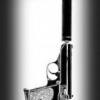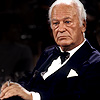-It is gunmetal in color
-It is flat and slim
-It is wide
-It holds 50 cigarettes (how different Morland cigs are from today's filtered Malboro "kings" for comparison, I do not know)
-Bond keeps it in his hip pocket.
-Shoved inbetween the pages of an Eric Ambler novel, Bond's cigarette case helped stop Grant's small caliber bullet, raising questions about the case's density, and/or if the book was more instrumental in stopping the bullet.
After some research (mostly through eBay
-Cases in gunmetal finish are very uncommon. Surely, some would have come up now and then if these were regularly manufactured, and I've come across only one vintage specimen, which was more dissimilar than it was similar to Bond's case in many aspects.
-The largest specimens are around 7 to 8 inches long, not as common as 4 inch cases, which stores cigarettes on only one side and can carry only 20-25 cigarettes. I haven't seen double-sided cases of this length, but if they existed, they would no longer be "slim" as Fleming described.
-Most UK made vintage cases are from Birmingham, and made out of sterling silver.
-Anything related to cigarette cases that can carry 50 cigarettes are vintage cigarette tins, and interestingly there is a specific category for cigarette tins called "Flat 50." Their dimensions are only 4 1/2 x 5 3/4 inches and these are surprisingly thin due to them being constructed from tin.
-None of these "flat 50" tins are in gunmetal; the closest, however are Player's Navy Cut (there coincidentally are 2 lit Bond connections, "Players" from TB and of course, "Navy"), which has a matt black background, a gold border, the Player's logo on the upper left corner, and "50 Cigarettes" stenciled on the lower right corner:

-Of the all the cigarette tins I've come across on eBay (there are several hundreds at any one time) none of these are "plain," and are either lithographed or embossed with the cigarette brand. The closest to "plain" are pre-WWII (?) specimens that were unembossed, bearing no lithograph, but with the paper label glued on; these are rare compared to the lithographed specimens.
-Cigarette tins of 50 were issued as part of standard rations given to British military personel by the government or the Red Cross; similarly, Ronson produced uniquely matt-black finished lighters during the war.
In line with how Fleming's wartime experience heavily influenced his writing, I'm begining to think that Fleming himself used a wartime Ronson, and recycled a "flat 50" cigarette tin to carry his Morland specials (in keeping with some of his eccentric and frugal practices), except that when he adopted these for Bond, with artistic license he transformed the case's finish to gunmetal, an ideal and favorite color of his it seems.
Last year, I bought a 7-inch long, vintage Sterling silver case from eBay, had it finished in gunmetal (not as dark as the movie version), but observed that it is too heavy and long to carry in the hip pocket of my slacks. Based on my earlier findings, I thought a case like mine was a very close approximation to Bond's cigarette case, but I am now having doubts.
If Bond's case in the real world is based on these cigarette tins, it certainly (again) changes my preconception of the character. These tins are certainly lighter than sterling, with a smaller dimension and a greater capacity for cigarettes (in fact, exactly the count of 50 as described by Fleming).
On the contrary: (1) Were "flat 50" cases ever made in a generic, unadorned gunmetal finish? If not, of course, there's the possibility of Fleming taking fictional liberties. (2) Would a tin case help stop a bullet? If in his mind he indeed envsioned Bond's case to be tin, this can be accounted by another one of Fleming's occasional technical lapses, just as his choice for Bond's pistol in FRWL was "corrected" by Geoffey Boothroyd. (3) Isn't a cheap cigarette tin out of character for Bond? To some preconceptions like mine, yes, which earlier made me opt for getting a sterling cigarette case because the quality was a natural extension of Bond's finer tastes; but Bond has also shown himself to be frugal with many aspects of his lifestyle, perhaps as a reflection of Fleming himself.
Are there any Tobacciana experts and/or Fleming scholars out there who can comment? Thanks for reading.
Edited by superado, 25 January 2006 - 10:40 PM.




